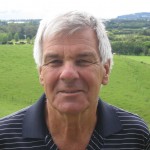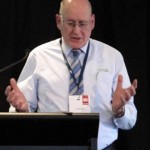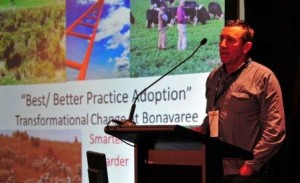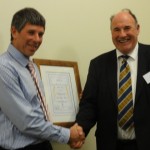Sciencelens has mathematical proof that sheep can speak English! Read on …
Tag Archives: sheep
Alliance getting ready for new season
Meat processor and exporter Alliance Group, like many others, has been busy getting ready for the new meat export season. The company has announced new plant and process modifications at two of its South Island plants, Pukeuri and Lorneville, recently.
Additional shift and modifications at Pukeuri
Alliance is to provide an additional shift at its Pukeuri plant as it ramps up cattle processing in the peak period, the company announced last week.
The third shift at the plant north of Oamaru will enable the company to process 880 extra cattle a week through May and June when the cattle throughput traditionally hits its peak. the third shift will also offer about 80 existing employees from the sheep and lamb processing shifts a longer season.
Alliance Group is currently undertaking a number of modifications to the plant, including extending the cattle yards ahead of the change.
John Brader, general manager of processing at Alliance Group, says the additional third shift was necessary to ensure Alliance continues to meet the needs of its suppliers.
Alterations have been made in Alliance’s systems to accommodate the additional cartons, giving more flexibility to which blast freezers or equilibration chillers the product can be directed, he explained.
Pukeuri processes more than 10,500 sheep and lambs a day. More than 900 staff work at the plant, which is the largest employer in North Otago. It is estimated the plant injects around $100 million into the local economy each year.
New rendering plant at Lorneville
In addition, Alliance announced that it has also completed the construction of the building for a new $13 million rendering plant at it’s Lorneville plant near Invercargill. Rendering machinery is now being installed in the 1,121 square metre building. The facility, which is designed to reduce Alliance’s energy and operating costs, as well as improve product recovery, is expected to be commissioned in October.
The new plant incorporates the latest technology, including a Press Dewatering System, which uses less energy and produces high quality products. When fitted with a waste heat evaporator, the process is virtually ‘zero waste’, resulting in high product yields and low wastewater output.
The first stage in a larger rendering redevelopment project, two further stages are proposed in the future. The complete project is said to save 9,000 tonnes of lignite and more than 1.5 million hours of electricity a year, enough to power 170 homes a year, the company says.
John Brader says the new rendering plant represented the largest single investment at the Lorneville plant for more than a decade.
“Completion of the building marks a major milestone for the development. Rendering remains a significant contributor to Alliance Group’s income and the investment in the latest technology will ensure we maximise revenue in this area.
“Alliance measures energy use and the associated greenhouse gas emissions from its plant to assist in making good business decisions.
“Since 2000, Alliance Group has reduced greenhouse gas emissions from energy use at its processing plants by 26 percent per unit of production and total fuel use has been reduced by 32 percent.”
Almost 2,000 people are employed at Lorneville, which is New Zealand’s largest sheepmeat processing plant.
Try lamb, says joint promotional group
A joint promotional push is getting United States consumers to try lamb.
Project partners involved with the Tri-Lamb Group, which has a goal to get more Americans eating lamb, are meeting with two Beef + Lamb New Zealand (B+LNZ Ltd) farmer directors.
Central South Island director, Anne Munro and Southern South Island director, Leon Black are in Idaho, representing New Zealand sheep farmers alongside their fellow Tri- Lamb Group representatives from Australia and the United States.
B+LNZ Ltd chief executive Dr Scott Champion says the collaborative promotion by the three sheep producing nations is built around the understanding that the profitability and sustainability of the lamb market in the US is important for farmers in all three countries.
“If more Americans are eating lamb, then each country stands to gain from the opportunities that increased consumption will provide.
“The programme includes online food and nutrition blogs that share lamb recipes and podcasts showing how to build simple and healthy lamb meals for the family. They’re tracking a lot of interest.
“This week the Group reviewed last year’s programme and considered continuing support for the initiative, called ‘Making Lamb Famous in the United States’.”
For the year ended 30 June, the United States was New Zealand’s third largest sheepmeat market by value (NZ$256 million), behind the United Kingdom (NZ$534 million) and Germany ($NZ275 million) and ahead of China (NZ$247 million).
View Lean on Lamb online food blog.
Sheep scanning recognised as revolutionary tool
A revolutionary tool for reproductive management of sheep in New Zealand, which has contributed to the country’s improved meat production over the past two decades, has been recognised in the inaugural Sheep Industry Awards, alongside the top flocks and sires for genetic merit.
About 200 people attended an event in Invercargill earlier this month to celebrate sheep farming excellence and to witness the presentation of nine awards covering genetics, production and business innovation. Results of the genetics-related awards were calculated based on breeders’ performance in SIL-ACE (Advanced Central Evaluation) – the large-scale, across flock and breed genetic evaluation of more than 280 ram breeding flocks.
The Silver Fern Farms award for sheep industry innovation went to Rowan Farmer, who was responsible for introducing and promoting sheep pregnancy and eye-muscle scanning technology to New Zealand.
Farmer set up Stockscan in 1991. The primary aim was to scan sheep for eye muscle area, but Farmer’s experience with quarantined sheep at Invermay gave him an insight into the management benefits of pregnancy scanning. Since then, the practice has expanded to include the identification of twins and triplets. Scanning has revolutionised the reproductive management of sheep throughout New Zealand.
In addition, the country’s top performing breeders of meat yielding sheep were honoured. Joseph and Judy Barker’s terminal sire flock ‘The Burn’ Texel stud in Mid-Canterbury rated highest for genetic merit across the SIL-ACE evaluation, The dual purpose (ewe breed) flock rated highest for genetic merit was ‘MNCC’, Edward Dinger’s Coopworth stud in the Waikato. The same flock also won the Alliance High Performance Flock award.
B+LNZ geneticist Mark Young says the process of identifying the top-performing flocks involved analysing the top 25-50 percent of rams for each specified set of traits, before then adjusting the results to account for variatons in flock size.
“This exercise also identified highly-rated sires that were making a big impact in industry. The B+LNZ Super Sires are rated in the top 10 percent for genetic merit in indexes of merit across key traits. They are also rams which have been used a lot, so have the most progeny,” says Young.
The B+LNZ Ltd Award for an individual or business making a significant contribution to the New Zealand sheep industry went to Dr Jock Allison ONZM. Two of the highlights of his career, from the sheep industry viewpoint, have been his work with the Booroola Merino which led to the discovery of a major gene fecundity gene and for importing the East Friesian sheep to this country.
The idea to hold an awards ceremony was initiated by B+LNZ Farmer Council Member and ram breeder Russell Welsh. Welsh says the dairy industry’s track record of celebrating success promoted him to suggest the awards ceremony. “It highlights best practice and,by default, that lifts all farmers.
B+LNZ Ltd chairman Mike Petersen says it is great to see farmers driving an initiative which celebrates the sheep industry, while also highlight the immense value of SIL’s database to the sector.
Other award winners on the night were:
- AgITO Business Farm Trainer of the Year –Smedley Station and Cadet Training Farm.
- Dual Purpose plus Worm FEC Flock (Index: Reproduction + lamb Growth + Adult Size + Wool + Parasite Resistance) – Nithdale Romney flock, owned by A Tripp of Gore.
- Dual Purpose plus Facial Eczema Flock (Index: Reproduction + lamb Growth + Adult Size + Wool + FE Tolerance) – ARDG Romney Flock, R & G Alexander of Tirau.
- Beef + Lamb New Zealand Super Sires – in addition, top sires were also picked out in six categories: terminal; dual purpose*; dual purpose high performance*; dual purpose plus meat yield*; dual purpose plus worm FED; and dual purpose plus facial ezcema tolerance. A Coopworth Ram owned by Steve Wyn-Harris of Waipukerau won three of those spots (marked *), really making it the Super Sire.
For more information see www.beeflambnz.com.
Cooper ‘walking the talk’
Aside
The purchase of a 245 hectare sheep and beef finishing farm last year means that Siver Fern Farms’ chief executive is now ‘walking the talk’, according to an article in the Otago Daily Times. As a farm owner, the article says, Cooper better understands farmers’ problems and challenges and is using that knowledge to help shape the company to meet those needs. Read more …
Market will cope with extra lambs
 The market should be able to cope with the expected one million more lambs this season, suggests meat industry commentator Allan Barber.
The market should be able to cope with the expected one million more lambs this season, suggests meat industry commentator Allan Barber.
Responding to recently released figures from B+LNZ Ltd’s Economic Service Barber points out that last year’s 4.4 percent reduction led sheep numbers to an all time low and that this season saw a bounceback of 2.6 percent, largely from an increase in ewe hoggets.
“Providing adverse weather doesn’t cause larger than anticipated lamb losses, there is every reason to expect one million more lambs on the ground this season,” he suggests, adding that this will prompt the question as to whether the markets can absorb the extra lambs, given the flat state of most overseas economies and the significant amount of inventory clogging up the pipeline.
“Past experience suggests that the pipeline will free up, so buyers will hopefully start to place orders again in the not too distant future. In addition, the growth last season meant that farmers held back stock and continued to put weight on. At the same time, meat exporters failed to give the right market signals soon enough, because they had to keep prices high to secure throughput,” explains Barber.
“Assuming the law of climatic averages reasserts itself, the coming season will return to more normal conditions. Therefore, the conflicting messages of procurement and market price will not be so far out of kilter again and supply and demand will be more complementary.
“If not, we will have to pray for an outbreak of rational behaviour from producers and processors!”
Barber notes that the changing nature of land use in New Zealand can be seen from the fact that the North Island is now home to more sheep than the South Island for the first time in living memory. At the same time, the South Island, assisted by irrigation, now has 35 percent of the country’s dairy cows, “a proportion which was inconceivable 15 years ago,” he says.
Stock numbers holding
 The good pastoral production year has seen New Zealand sheep numbers increase by 2.6 percent and beef cattle numbers increase by one percent for the year to 30 June 2012, according to Beef + Lamb NZ Ltd’s Economic Service.
The good pastoral production year has seen New Zealand sheep numbers increase by 2.6 percent and beef cattle numbers increase by one percent for the year to 30 June 2012, according to Beef + Lamb NZ Ltd’s Economic Service.
“This partly makes up for the 4.4 percent decline in sheep and 2.6 percent decline in beef cattle the year before,” says executive director Rob Davison.
B+LNZ’s annual stock number survey, which establishes the productive base of livestock for 2012-2013 shows that while sheep numbers were up 2.6 percent most of this increased will be stock carried over for slaughter in July-September.
Ewe condition is good across the country, he noted. “Scanning results for most regions show in-lamb ewes are carrying more multiple lambs with the general comment that scanning percentages are up five to 10 percent on last year. All we need now is an excellent sprint to ensure high survival of the lambs born.”
The scanning results lead to expectations that the 2012 lamb crop could be up on last Spring by one million lambs (+ four percent). This outcome would lift the ewe flock performance measured by lambing percentage to around the highest achieved, which in 2009-2010 was 123 percent. There is potential to exceed this performance level, Davison says. Each one percentage point change in lambing percentage, equates to about 200,000 lambs.
Transformational change (and how to make it)
 One farmer who has made transformational change to his farm business is Marlborough farmer Doug Avery.
One farmer who has made transformational change to his farm business is Marlborough farmer Doug Avery.
In an inspirational and entertaining presentation at the Red Meat Sector Conference, he talked of working “smarter and harder” and the need to “lift yourself up above and see what’s going on around you.”
The tipping point that made him see that he needed to change was sustained drought in the region, over a period of eight years, which meant that Bonavaree Farm and the Avery family were facing a very uncertain future. In 1998, Doug Avery attended a seminar where Lincoln University pasture Professor Derrick Moot proposed using lucerne as a primary grazing pasture plant. Using that idea started change.
In 2004, with the area still gripped with drought, the NZ Land Care Trust answered a call for help from Avery and a few other farmers. A six-pronged attack on failed systems was engaged with science and the help of funding from the Sustainable Farming Fund and others. This saw the transformational change of the operation from one of failure to one of success.
Having run the emotional gamut of the ‘Three Ugly Sisters’ – envy, anger and blame – Avery realised, when he started looking, that there were some things he could control and others he was concerned about – climate change, weather and the value of the dollar – that he had no control over at all.
Avery realised three things: that the farm business could run 44 percent less sheep but only produce five percent less product; also, that a one percent increase in soil carbon can increase water holding capacity by 144,000 litres per hectare; and, finally, “how much time do we spend telling our story?”
Change of mindset
A change of mindset was also needed, he decided. He would work in what he calls the influence circle, become proactive not reactive, move to solution and enquiry (away from blame and excuse), he would influence thinking and adapt his business systems to the changing climate.
Better practice influenced the systems in place at Bonavaree, says Avery. The year was broken down into three periods: the risk period from mid-December to mid-February where they farm as little as possible; the recovery period from mid-February to late winter, when crops are grown on summer-fallowed land and ewes and hoggets are mated on lucerne and the system charges back into life; and the revenue period, from late summer till mid-December.
“We grow our stock at fast rates to finishing weights before the summer dry,” he said, adding that ewes wean fat and the ewe weights are heavy.
Precious water was conserved by using summer fallow, which intercepted the weed cycle, storing water and creating a water reservoir. Organic matter was built into the soil by stopping tillage. Plants were used that could tap water from deeper layers and also create rapid animal growth and performance. Finally, animals were made for performance, using designer genetics.
Results
The results today speak for themselves. “Lots of wonderful lambs that grow like mushrooms”, and “hogget scanning gone from 40 percent to 165 percent”.
Today, Bonavaree has 1,500 hectares owned and 280 ha leased which will be wintering 13,000 stock units this year (5,000 sheep, 1,650 cattle), growing 90 ha of lucerne for seed and the family is retiring an increasing number of natural areas production. The property has six full-time staff and lots of busy contractors.
Better practice
Better practice for Avery is about using quality contractors, rather than trying to purchase expensive machinery and do it himself, using smart systems like Farmax, inspiring the young who learn by what they see, working with good value chains and smart brands, growing top crops and lambing onto top quality feed, he said.
Reminiscing to the start of his transformational journey, Avery said: “I always wondered why somebody didn’t do something about that, then I realised I am somebody.”
His message for farmers looking to create resilient businesses is to create relationships, manage the soil and water “more crop from every drop”, look at the plant selection for sites and purpose, manage feed supply and demand, work with the natural forces of the local climate, collaborate with science, agency and industry, engage in processes which create financial reward and to create a culture of excitement and fun in the work place.
Bonavaree is now looking to build on its successes through improved management structures, more measuring and collaboration through FarmIQ, better feed conversion in the rumen, improved plant mixes and genetics (plant and animal) and enhanced native plantings and over lay business, says Avery.
Doug Avery has received a number of award for his work at Bonavaree including the 2008 Green Ribbon from the Ministry for the Environment, 2010 Lincoln Foundation South Island Farmer of the Year, 2011 Marlborough District Council Farm Environment Award and the 2012 New Zealand Land Care Trust Ambassador title.
2012 Landcorp Agricultural Communicator of the Year
Congratulations to Steve Wyn-Harris, a Hawke’s Bay sheep and beef farmer and farming commentator, who has just been announced as the 2012 Landcorp Agricultural Communicator of the Year.
Wyn-Harris started his farming career in 1985, when he bought 180 hectares in Central Hawke’s Bay, adding several other blocks over the years, so he and his wife now have 350ha. The properties carry high performance breeding ewes, including a Coopworth sheep stud that uses the latest technology such as sire referencing, AI and gene identification. Bull beef makes up 40% of the stock carried and 15% of the property is planted in forestry and areas of amenity and native plantings are scattered over all the farms. He has won a number of farming awards over the years, most recently last year when the farm took out the East Coast Balance Farm Environment Supreme Award.
He took out this year’s award as a broadcaster with his own local radio show and a regular on the national Farming Show. He is also a longstanding columnist and has been contributing weekly columns for many years and currently appears in NZ Farmers’ Weekly.
The Award is administered by the NZ Guild of Agricultural Journalists and Communicators (NZGAJC) and recognises excellence in communicating agricultural issues, events or information. regarded as the premier award for agricultural communicators, it is also the most valuable prize on offer. Landcorp provides a prize of $2,500, which is part of a funding package of $7,500 in sponsorship for the Guild. The additional funding assists with administration costs, including the award dinner.
Guild President, Jon Morgan, said Steve is a worthy recipient of the award this year. His columns, comments, presentations at conferences cover an extensive range of topics, but his style remains the same, relaxed, whimsical and often humorous. “He is widely respected as an excellent farmer, but has that rare gift of communication that crosses all areas of rural life.”


